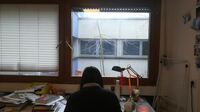Problem
Zum Anfang Zum Anfang Zum Anfang Zum AnfangWonder
In the last two months, we observed breaths, listened to them, and read about them. We talked about them, visualized them, and experimented with them. We are interested in what kinds of knowledge, emotion, and imagination arise in this process. What kinds of stories our encounters with breathing enable us to tell? What kinds of 'wonder-knots' can we tie around breathing?
Thinking with Decartes, Irigaray (1993) sees wonder as providing the basis for an ethics of sexual difference, because wonder is prior to judgement and nonhierarchical. Unlike other passions such as love, hate, or desire, wonder has no opposition. It "never tak[es] hold of the other as its object" and maintains their autonomy [between the sexes] within their statutory difference, keeping a space of freedom and attraction between them, a possibility of separation and alliance” (Irigaray 1993, 13).
Our (Florian and Daniel) wonders at breathing therefore do not and should not serve as a pretext for the wilfulness to know, an unreflected enterprise that often veils a desire to dominate. With this concept, we hope to keep a nonhierarchical, nonrepresentational ,and nonlinear relation between us and the phenomenon of breathing.
Being in Breathing
Being in breathing
“[T]he body is already a respiratory body.” (Merleau-Ponty 1964, 122)
Anxieties
Breathing in precarity
“Precarity is the condition of being vulnerable to others. Unpredictable encounters transform us; we are not in control, even of ourselves…we are thrown into shifting assemblages, which remake us as well as our others…A precarious world is a world without teleology. Indeterminacy, the unplanned nature of time, is frightening, but thinking through precarity makes it evident that indeterminacy also makes life possible” (Tsing 2015, 20)
Klangstudien
Beobachtung
Die Beobachtung meiner Atmung und des Effekts meiner Atmung auf meine Atmung verstehe ich als einen »moment of wonder«. Ein Moment des »reimagining« der Relationen von Atmen. In diesem Experiment wurde für mich der situative Charakter des Atmens erfahrbar.
Die Aufnahme und ich traten in eine Beziehung und in eben dieser Relation verkörpert und materialisiert sich eine gemeinsame Sphere.
Die Aufnahme wirkte auf mein Atmen, indem es meinen Rhythmus unterbrach, dadurch entstand einerseits eine neue Rhythmik andererseits wurde ich mir in diesem Moment der Störung meines Atmens bewusst.
Temporality
Time
Breathing into the Deep Time
Audio RecordingsPerception of Temporality Pt. I
Audio RecordingPerception of Temporality Pt. II
Temporality
Die Intention dieses Stückes ist es einerseits, die Zeitlichkeit des Atmens hörbar zu machen, andererseits hat sich herausgestellt, dass es sehr gut Karen Barads Konzept der Intra-Aktion demonstriert, das später von Magdalena Górska auf das Atmen übertragen wurde.
Magdalena GórskaAtmen - Ein intra-aktives Phänomen
Spatiality
Space
Space of breathing
A more than human Composition of Breathing
Audio/VideoA More than human composition of breathingWARNING FLASHING LIGHTS
Diese Komposition sollte wenn möglich mit Kopfhörer gehört werden, da dem Stück ein bestimmte Räumlichkeit zu Grunde liegt, die nur im Stereobild erfahrbar wird.
Epilogue
Epilogue: Breathing-in-this-time-and-space
Literature
Irigaray, Luce. 1993. An Ethics of Sexual Difference. Trans. Carolyn Burke and Gillian C. Gill. Ithaca: Cornell University Press.
Haraway, Donna. 2016. Staying with the Trouble: Making Kin in the Chthulucene. Durham; London: Duke University Press.
Kleinberg-Levin, David Michael. 2018. Logos and Psyche: A Hermeneutics of Breathing. In: Škof, Lenart and Berndtson, Petri (eds). Atmospheres of Breathing. Albany: SUNY Press. 3-24.
Škof, Lenart and Berndtson, Petri. 2018. Introduction. In: Škof, Lenart and Berndtson, Petri (eds). Atmospheres of Breathing. Albany: SUNY Press. ix-xxvii.
Tsing, Anna Lowenhaupt. 2015. The mushroom at the End of the World: On the Possibility of Life in Capitalist Ruins. Princeton [u.a.]: Princeton University Press.
































 Vergessen
Vergessen
 Eine kurze Einführung
Eine kurze Einführung
 Ausgangspunkt
Ausgangspunkt
 Wonder
Wonder
 Haraway Knots
Haraway Knots
 Breathing-in-this-time-and-space
Breathing-in-this-time-and-space
 Being in breathing
Being in breathing
 Anxieties
Anxieties
 Anxieties
Anxieties
 Breathing into the Deep Time
Breathing into the Deep Time
 Perception of Temporality Pt. I
Perception of Temporality Pt. I
 Perception of Temporality Pt. II
Perception of Temporality Pt. II
 My breathing space
My breathing space

 Audio und Video A more than human composition of breathing
Audio und Video A more than human composition of breathing